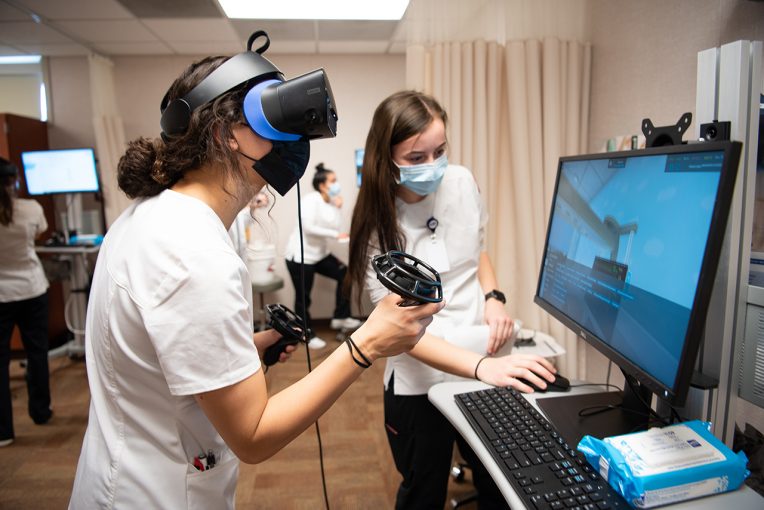A Mennonite College of Nursing (MCN) student is working with a patient who has come into the hospital due to a positive case of coronavirus (COVID-19). As the student moves through the standard routine of checking vitals, the patient begins to suddenly decline, turning blue and struggling for air. The decisions the nurse makes in the next few moments are now a matter of life and death.
What would be an intense experience for any nurse is made easier by knowing that it is only a simulation made possible by virtual reality (VR) technology available at MCN’s Nursing Simulation Lab. Lab Director Joanna Willett said the technology is a way to further enhance the many educational opportunities already available in the lab.
“Our whole purpose in this building is to provide a safe environment where students can deliberately practice as well as perform in an area where they don’t have the chance to potentially harm people,” Willett said. “We have these selected scenarios so that they can have these guaranteed repeatable encounters safely, both physical and psychological.”
MCN has long been interested in using virtual reality to enhance learning, but the technology was either too expensive, too complicated, too limiting, or a combination of all three for what they needed it to do. After receiving funding through Provost Academic Enhancement Funds and researching different medical VR software, MCN purchased UbiSim. Four undergraduate courses use the technology and MCN hopes to see that expand further, especially once the simulation lab itself expands.
One of the primary features that made UbiSim stand out to MCN was the ability for staff to create their own simulations without having any coding experience. In addition, there is an online share space where colleges and universities using UbiSim can upload the scenarios they created for others to use.
Instructional Assistant Professor Nina Ford had never experienced VR before these courses and had initial concerns about her ability to learn VR well enough to teach students with it. She has gone on to create several of the 16 scenarios developed and used by MCN staff.
“I have the student as a nurse standing in a pediatric clinical hospital room and they see the physical hospital room, the patient, the parent at the bedside, oxygenation on the wall, a vitals cart, medical tray, and an electronic medical monitoring system,” Ford said. “Whatever you would typically find within that live scenario is what they walk into.”
Students have also adapted to the new technology, in part because VR headsets are increasingly finding their way into homes for recreational use. Even still, all MCN students who use VR go through an orientation to get comfortable with the Oculus Rift headset and the controllers they use to simulate their hands.
“You don’t feel the pressure of other people around you because when you’re in VR you feel as if you are standing in the hospital room with the patient, even if you’re standing in a classroom,” said senior Liz DelPonte.
Once in the VR space, students can interact with the patient, objects in the room, and even each other if multiple students are part of the same scenario. To move around the virtual room, students gesture to set points in the room to teleport to that location. This allows students to help the patient in the virtual world while staying safe in the real one.
Willet said the scenarios are designed to give students a space to be brave in the face of an intense situation that simulates those they will experience as working nurses. Having a space to learn, experiment, and make mistakes safely is where the VR tech shines.
“We know that as humans, we all make mistakes,” Willett said. “We start the day letting our students know that they are intelligent, they are capable, and that they are going to do their best. We believe that 100 percent. In this college, and especially in this lab, that is what we are all about.”
The VR scenarios provide a blueprint for how students will handle a situation, giving instructors the ability to work with them individually on their strengths and weaknesses. For Ford, seeing students improve each time they enter a simulation makes the initial learning curve worthwhile.
“It’s really nice to see a student come in and see that they can flourish and that they can do well and build that confidence in themselves,” she said.

